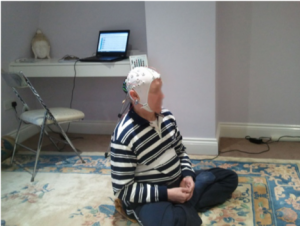Meditation Reduces the Complexity of Brain Activity
By John M. de Castro, Ph.D.
“What happens in your brain when you meditate. . . The overall difference is that our brains stop processing information as actively as they normally would.” – Belle Beth Cooper
Meditation training has been shown to improve health and well-being. It has also been found to be effective for a large array of medical and psychiatric conditions, either stand-alone or in combination with more traditional therapies. There are a number of ways that meditation practices produce these benefits, including changes to the brain and physiology. One way to observe the effects of meditation on neural activity is to measure changes in the electroencephalogram (EEG), the rhythmic electrical activity that can be recorded from the scalp.
In today’s Research News article “Contrasting Electroencephalography-Derived Entropy and Neural Oscillations With Highly Skilled Meditators.” (See summary below or view the full text of the study at: https://www.ncbi.nlm.nih.gov/pmc/articles/PMC8119624/ ) Young and colleagues recruited experienced meditators who engaged in six different meditation styles (shamatha, vipassana, zazen, dzogchen, tonglen, and visualization). They had on average 21,935 hours of meditation experience. The researchers then recorded the Electroencephalogram (EEG) while the meditators were thinking about their day and also during meditation practice. The EEG recordings were analyzed for entropy and their power spectra.
They found that tonglen and zazen meditators had the highest alpha rhythm power during meditation compared to other styles of meditation. But different styles had markedly different patterns. On the other hand, overall, with all meditation types there was a significant reduction in entropy of the brain activity during meditation.
The differences in the power spectrum observed with different meditation types probably reflects the different mental activity encouraged by the individual practices, On the other hand there were consistent findings with the entropy measures suggesting a common element of neural activity occurring with meditation regardless of its form.
Entropy of the pattern of Electroencephalogram (EEG) activity is a measure of the complexity of the activity. The reduction in entropy observed during meditation suggests that meditation is associated with a simplification of brain activity. This makes sense as during meditation attention is focused, reducing the variety of mental activity. Hence, the simplified mental experiences during meditation are reflected in a simplified neural activity.
So, meditation reduces the complexity of brain activity.
“It seems the longer you do meditation, the better your brain will be at self-regulation. You don’t have to consume as much energy at rest and you can more easily get yourself into a more relaxed state.” – Bin He
CMCS – Center for Mindfulness and Contemplative Studies
This and other Contemplative Studies posts are also available on Google+ https://plus.google.com/106784388191201299496/posts and on Twitter @MindfulResearch
Study Summary
Jacob H. Young, Martha E. Arterberry, Joshua P. Martin. Contrasting Electroencephalography-Derived Entropy and Neural Oscillations With Highly Skilled Meditators. Front Hum Neurosci. 2021; 15: 628417. Published online 2021 Apr 30. doi: 10.3389/fnhum.2021.628417
Abstract
Meditation is an umbrella term for a number of mental training practices designed to improve the monitoring and regulation of attention and emotion. Some forms of meditation are now being used for clinical intervention. To accompany the increased clinical interest in meditation, research investigating the neural basis of these practices is needed. A central hypothesis of contemplative neuroscience is that meditative states, which are unique on a phenomenological level, differ on a neurophysiological level. To identify the electrophysiological correlates of meditation practice, the electrical brain activity of highly skilled meditators engaging in one of six meditation styles (shamatha, vipassana, zazen, dzogchen, tonglen, and visualization) was recorded. A mind-wandering task served as a control. Lempel–Ziv complexity showed differences in nonlinear brain dynamics (entropy) during meditation compared with mind wandering, suggesting that meditation, regardless of practice, affects neural complexity. In contrast, there were no differences in power spectra at six different frequency bands, likely due to the fact that participants engaged in different meditation practices. Finally, exploratory analyses suggest neurological differences among meditation practices. These findings highlight the importance of studying the electroencephalography (EEG) correlates of different meditative practices.
https://www.ncbi.nlm.nih.gov/pmc/articles/PMC8119624/

Agree fully that meditation where we exercise voluntary attention reduces disorder and thus reduces uncertainity and randomness.this allows parasympathetic nervous system to be activated leading to better appetite and sleep control of stress. Thus we can infer that meditation is life enhancing